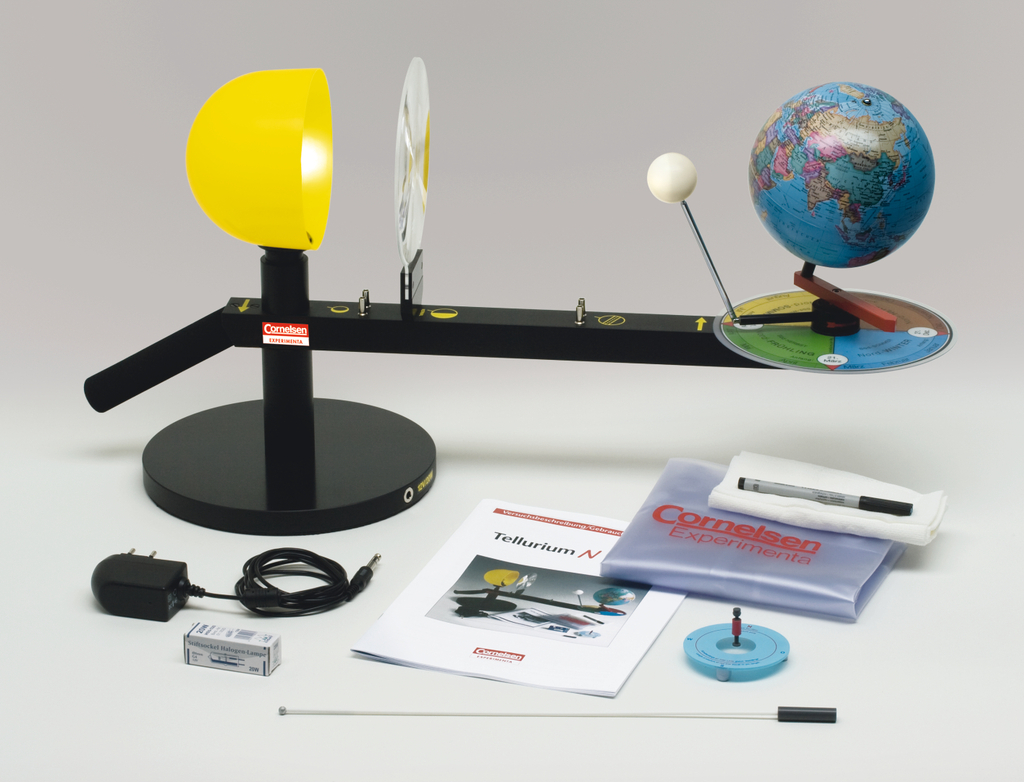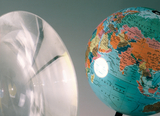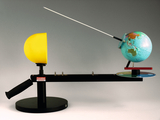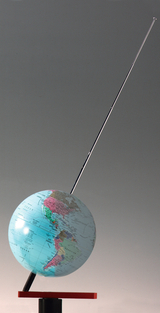Tellurium N
The particular innovations are the use of a Fresnel lens to produce an extra bright and parallel light beam which illuminates the earth globe completely.
Further the focussing of a light point on the globe to demonstrate the apparent movement of the sun between the tropics and the use of a horizon disc with shadow-pin figure to show the position of the sun by the shadow fall.
The Tellurium N was designed by Prof. Dr. J. Newig, Kiel in cooperation with Cornelsen Experimenta.
The Fresnel lens:
A short focal length provides a directed, parallel light with the result that a full half of the globe is illuminated and the shadow line (day and night) corresponds with the nature.
Formerly designed Telluriums are not able to show it like this.
The three positions of the Fresnel lens:
- Day and night, seasons: The globe is fully illuminated and the shadow line is clearly visible.
- Tropics (sun-point): The lens focuses a small light point with a ‘hale’ on the centre of the globe. When the earth is turned around the sun the light point moves across the equator between the northern and southern tropic.
- Lunar phases: The moon will especially be illuminated. When the moon is turned around the earth by hand the lunar phases and the eclipses can clearly be demonstrated.
Age 8-18
Horizon disc with shadow pin figure
- To explain the changing situations of illumination on earth easily comprehensible.
- Can be put on the globe at any place.
The satellite rod
To demonstrate the position and movement of a geostationary satellite a rod with a ‘satellite’ on the top can be set on the shadow pin figure of the horizon disc.
The moon on a telescopic support rod
The moon can be moved around the earth by hand and adjusted in height to demonstrate lunar phases and eclipses.
The date disc and the date pointer
The earth globe is mounted on a large date pointer which moves around the date disc when the Tellurium arm is turned around the sun.
Corresponding to the date pointer position the earth axis is inclined towards or away from the sun (seasons). The dates of the summer- and winter solstice as well as the equinoxes are especially marked on the date disc.
The date disc is available in different languages.
The large earth globe...
Shadow line and other details are clearly visible on the globe even from a long distance.
... with telescopic rod
To demonstrate the position of the earth with its direction of the earth axis to a fixed point in space (the North Star).
Technical specifications
Complete with power supply unit, felt-tip pen, cloth, spare bulb and manual
Technical data:
Globe dia.: 15 cm
Lens dia.: 16 cm
Lamp: 12V/20W quartz-iodine
Size: 720 x 370 x 250 mm
Mass: 4 kg
The Tellurium shows us the movements of the earth around the sun and those of the moon around the earth.
We have to make it clear to the pupils that this conformity to a law applies to all corresponding celestial bodies of spherical shape, thus, e.g., to the moon, but also to our neighbouring planets. The same way as the moon sometimes is very brightly or practically hardly visible, also the planets change their brightness.
Explanation of the two phenomena of polar night and polar day.
Investigate the phenomena of the tropics using the sun point.
Observing the moon phases.
Explain the phenomenon of tides.
Show how to determine the circumference and radius of the Earth.
Explain how Muslim prayer times come about.
Overview of the origin of the times and the corresponding sun position.
Showing the origin of the seasons.
Point out the different times of day/night at different latitudes and the different seasons.
The times of day at different earth-sun positions at different latitudes are shown.
Pointing out the origins of the eclipses.
Show how to determine the circumference and radius of the Earth.
- 1 × Felt pen, water soluble
- 1 × Dust cover with bag for Tellurium
- 2 ×
- 1 ×








